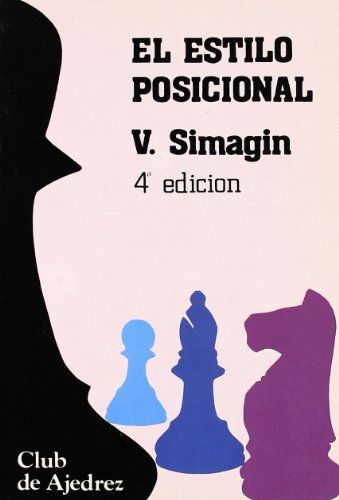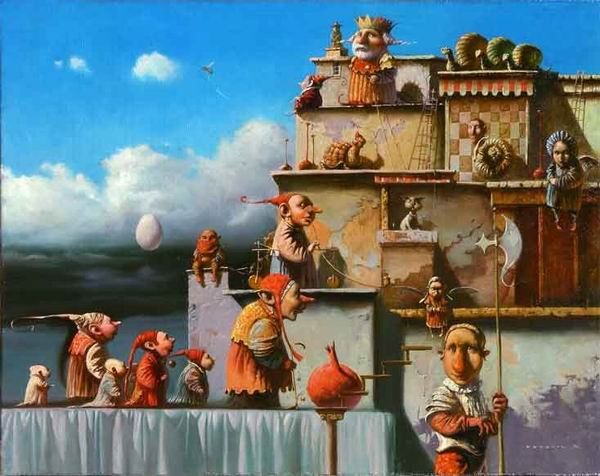
Heroes of the Past: GM Vladimir Simagin, Part 1
WHEN CHESS WAS STILL AN ART
This is the first part of my piece on Vladimir Simagin written several years ago on my (now defunct) chess blog. I dedicate it to my friend @SimaginFan who has been an inspiration to many of us with his deep, original and fascinating insights and brilliant observations on our beloved game, especially its history and many forgotten heroes of the past.
* * *
Every field of human endeavor has its heroes and legends. Some of them are praised a lot and gotten kind of cult status, like the World champions and the highest-tier members. But sadly, many other great minds have simply been forgotten. In chess, GM Vladimir Simagin is one of them.
Simagin (1919-1968) was a much-admired player, coach, theoretician, author (Best games, 1963) and journalist. He coached Kotov (1950) and Smyslov (1953-57). “A resolute character, an extraordinary talent,” Botvinnik.

Chess playing style
What was Simagin’s playing style like? Well, what is chess style anyway? The concept of it is only very vaguely defined. We tend to put players in two main categories, (1) attacking/tactical and (2) positional players. That is how Susan Polgar described styles on her chess blog citing Tal, Shirov, Topalov and her sister Judith Polgar in the former, and Smyslov, Petrosian, Karpov, Kramnik in the latter category. She also added an “all around” style, mentioning Spassky, Botvinnik, Fischer and herself.
So to which group did Simagin belong to?

According to Wikipedia, he was an expert tactician with a bold style. Following the above labeling and distinguishing of styles, that would fit in the category (1) above.
However, as we know, masters blend strategy and tactics all the time and the distinction between tactical and positional can’t serve as a foundation for defining chess style. Tal possessed as much positional brilliance as Petrosian did tactical one.
Chess is by default positional, Reshevsky put it in The art of positional play (Random House, 1976). A positional advantage is a prerequisite for a successful attack. You need to learn how to get that positional advantage (or if you play inferior opposition, just wait for them to make some positional concessions).
There are three elements of chess art: (1) deciding on a positional objective, (2) planning a strategy to achieve it, (3) carrying out the strategic plan tactically (calculating specific moves and variations). The terms “positional” and “tactical” can’t therefore be used as opposites. Doing so, Reshevsky adds, would be “as wrong as to consider a painting’s composition unrelated to its subject.”

Sergey Kuznetsov, Confrontation, 1996
.
So, if there is a distinguishing characteristic of chess style, it must be something other than “positional” and “tactical” (sorry Susan). What the central feature of style may then be? (Well, we will return to what constitutes chess playing style in the next post.)
There is no much one can find about Simagin on-line, but here are some opinions from Russian chess books to help us try to define him as a player.
He was a “highly original and non-routine thinker” (L. Polugaevsky, in Grandmaster preparation), a “player with a highly original, unique and imaginative style of play; he was a chess philosopher and very educated personality with a great love for literature. He never gave his brain time to rest.” (D. Bronstein in Sorcerer’s aprentice).
In the Forward of Simagin’s Best games, Moscow 1963, Mark Beilin said that, although Simagin was a great combinative player, he tried to outwit his opponents strategically, creating positions not entirely satisfactory from the formal point of view, but what deep analysis would prove as solid and positionally advantageous later. Indicatively, his Best games were translated into Spanish as El estilo posicional and has seen four editions to date.
Which makes Simagin an ideal player for our Test your positional skills puzzle. This position is from Simagin-Gurgenidze, Kharkov 1958.
18. e5!
A decisive breakthrough by a positional pawn sacrifice.
Funny, I fed my Fritz with this position and set the number of lines to consider to ten. It didn’t even consider 18.e5. Not at all! (true, I wrote this piece several years ago, so cheap chip morons may have improved since). But it gave moves like 18.Reb1 attention?! This, once again, shows how positional “understanding” of chess engines in tranquil positions reaches grotesque proportions. Apparently, chess engines are programmed to play for space. Which devalued the game, according to David Bronstein, to mere struggle for domination over important squares and sectors. “Chess has lost its creative component. It is no more the game it used to be. The primacy of the struggle for space has led us to where chess has ceased to be a game.”
Following the space logic, the engine sees Black is controlling the e5-square four times. Yet, White hits in Black’s most fortified place! GM Zaitsev would call it Attack at the strongest point! (he wrote a book with the same title: Attaka v Silnom Punkte, 1971). Little tactics, seen, paradoxically, by a human strategist, not by the chess engine that is supposed to be superior in that very domain of tactics. The humans think differently, the chess master may intuitively spot in a second that, with disappearance of the two white central pawns, the lines will open up for a lively piece play, including b1-h7 diagonal for the queen. While at the same time the black e5-pawn will shut its bishop out of the game.
Of course, we can’t expect from digital morons to show any imagination, or to be creative. What is most disappointing though is that the current chess king’s style is very close to how machines play. A robotic style. (Hey, remember Tal?)
18…Nxe5 19. Nxe5 dxe5
19…Bxe5 20.dxe6 fxe6 21.Qg6+ is no better.
20. dxe6 fxe6 21. Nc4 bxc3 22.bxc3
As the result of the little tactics employed, White gained some obvious positional pluses:
1. the important lines are opened for white pieces to work along (while Black is unable to make use of the newly opened f-file),
2. the Black’s king side is irreparably damaged,
3. the knight is significantly stronger than the bishop, locked in by its own pawns.
The realization of this positional advantage is of only technical character now.
22…Rf5 23. Rad1 Rbf8
Black dreams of regaining some initiative, but he is unable to build any serious threats. He resigned at move 40 (use the replayer above to see the remaining part of the game).
.
Fear instiller
In the tournaments he played, everybody feared Simagin (Vik. Vasilev, Chess silhouettes, Moscow, 1961). Grandmasters would sit across him with a set face as they could expect all kind of surprises from him. Yet, away from the chessboard, one should not fear him; he was modest and humble guy, one who could stand by another man when the truth was at stake; he was polite, kind and tolerant.

Lilienthal and Simagin at the semifinal of the 23rd USSR ch, Moscow, 1955
.
Simagin established a strange relationship with chess. When playing in tournaments, he – what a weird man – would rarely glance at the current standings. He was content if the games were rich in original and creative ideas, consistent from the beginning to the end. For example, in the 1944 Moscow championship (Botvinnik, Smyslov, Kotov, Ragozin, Mikenas, Panov, Alatortsev, Lisitsyn took part) Simagin won eight games and lost eight. No draws. So much unlike today’s masters. No imagination, no creativity, no risks – twenty point rating loss would freak them out.
An original talent, Simagin was experimenting a lot, searching his own way. Again contrary to today’s players who are mostly searching what their beloved chess engines have to say.
Vladimir Simagin. A real chess artist. He died as befits a chess player – at the chessboard. He was playing at the tournament in Kislovodsk in 1968. He was only 49 years old.

The cover of Simagin’s Best Games from 1963; it’s seen four editions in Spanish as El Estilo Posicional

